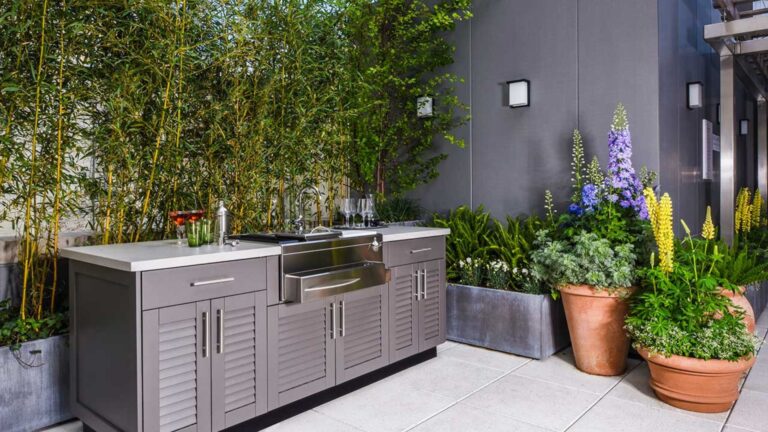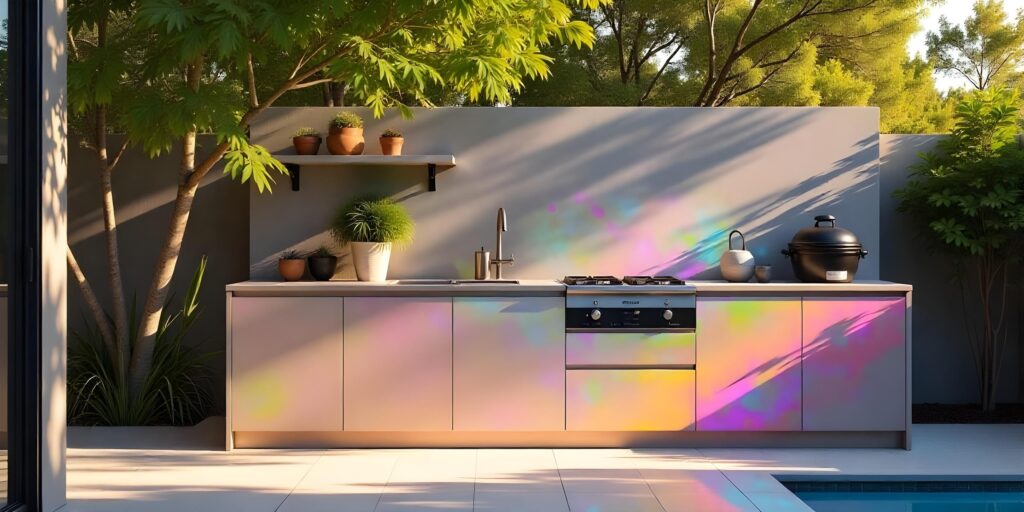It can be exciting to have an outdoor kitchen, but there are also many factors to consider when designing one. One of the things will be the outdoor kitchen cabinet materials you intend to use for your cabinets outdoor.
Most of the time, aesthetics and storage space are the main consideration when you are installing kitchen cabinets for your indoor kitchen. It can last at least 15-20 years if you maintain it in the correct way. But outdoor kitchen cabinets need to withstand the weather outside. The durability will be your main priority when you decide to get one.
@ampquartzcabinets Kalau nak rajin ke dapur, korang pastikan dapur korang ada functions ni semua tau!! #KitchenTips #KitchenHacks #AMPQUARTZ
♬ suara asli – ˢᵃᵈⁿᵉˢˢ – ˢᵃᵈⁿᵉˢˢ
It is important to invest in the right material for your outdoor kitchen cabinet, but with so many options in the market, you can be confused when making a decision. In this article, we will discuss some of the best outdoor kitchen cabinet materials to enhance the functionality of your outdoor kitchen.
Outdoor Kitchen Cabinet Materials 1: Stainless Steel

When deciding on the materials for outdoor kitchen cabinets, stainless steel is the most popular option for most homeowners. The durability allows it to withstand the weather outdoors. One thing you need to take note of is it can get rusty easily, but it wouldn’t rust much if you put on a powder coat finish.
What makes stainless steel kitchen cabinets suitable for an outdoor kitchen is their durability. But you need to ensure the cabinet is constructed with high-quality stainless steel. Most homeowners may be concerned about the rust, which is why it is important to choose high-quality stainless steel for the cabinet.
@ampquartzcabinets Transitional design gives you the best of both worlds! classic vibes with a modern twist 🏡 It’s all about clean lines, cozy details, and a look that never goes out of style. Perfect for anyone who loves timeless and trendy in one space! #KitchenDesign #TransitionalStyle #HomeInspo #TransitionalKitchen #AMPQUARTZ
♬ tell em x brazilian – 𝐀|𝐏
Opt for 304 or 316L grade stainless steel as it is resistant to corrosion. You may want to check or inform the cabinet installer that you are using for outdoors. A professional will know how to deal with it. For further protection, it is a good way to use powder-coated finishes. The powder-coated finishes have a wide range of decorative to choose from.
Also, you will need to pay attention to the thickness of the steel. It will affect the structural integrity. The best thickness will be around 16-20 gauge.
In conclusion, for outdoor kitchen cabinets, the finest material would have to be stainless steel. It's fantastically durable and able to withstand rust and corrosion from all kinds of weather. The sleek, modern look of stainless steel easily matches any outdoor theme, while its low maintenance will let it stay clean for many years.
Furthermore, stainless steel is very sanitary since it is a nonporous surface that bacteria and mould just can't seem to latch onto. For those wanting a material in their outdoor kitchen cabinetry, stainless steel represents one serious combination of strength and style with practicality.
Outdoor Kitchen Cabinet Materials 2: Aluminium
Aluminium is another popular choice for outdoor kitchens. The sleek and attractive look can enhance your outdoor kitchen design. Compared to stainless steel, it doesn’t rust, but it is susceptible to corrosion. Opt for powder coating to reduce the chances of corrosion.
Besides, the weight is lighter than other materials, which makes it easier for cabinet installers to install it, especially if you are using it for upper cabinets. But the material is soft, which makes it easier to get dent if any heavy object knocks on it. You don’t have to worry much about maintenance as you can just clean it with water and a cloth. It is also a good conductor of heat and has a lower melting point. It won’t be a good idea to place it near hot appliances.
Aluminium cabinets are ideal for outdoor kitchens because they can withstand any weather and are durable. This lightweight yet strong material has a very high resistance to rust and corrosion, so your cabinets will surely last for years to come. On top of that, aluminium is relatively easy to clean and maintain, making it practical for outdoor spaces.
Sleek and ultramodern in look, it greatly enhances any design of outdoor kitchen. Furthermore, its versatility allows different finishes and colours onto which the aluminium is fabricated. Though aluminium may be marginally more costly than some of these materials, its durability and low maintenance give its value for money invested in one's outdoor kitchen.
Outdoor Kitchen Cabinet Materials 3: High-Density Polyethylene (HDPE)

High-Density Polyethylene (HDPE) can be found in many furniture. It is a plastic polymer, which is known for its strength-to-density ratio. It is common for outdoor furniture due to its durability and easy maintenance. Just clean it with water, and it can look new.
With the colors available, it can enhance the visual appeal of your outdoor kitchen. Also, you don’t have to worry about rusting, corrosion, or rot. It is also resistant to most chemicals and solvents. It can be kept away from oils or grease from your cooking.
@ampquartzcabinets Selalu orang sama kan porcelain dengan sintered stone ni kan? Meh kitorang explain apa yang beza dan sama dia 👀 Ha sekarang dengan AmpQuartz, ada packages cabinet yang dapat sekali dengan sintered stone countertop tau! Buat dengan AMPQUARTZ jom! 📞 +6017 732 0149 (Jasmine) +6010 707 7815 (Lekha) +6010 719 7191 (Hema) https://go.wa.link/ampquartz #SinteredStone #SinteredStoneCountertop #PorcelainCountertop #HomeDecorMalaysian #kitchendesign #KitchenCabinets #KitchenCountertops #KabinetDapurJohor #KabinetDapurJB #KabinetDapurUluTiram #KitchenCabinetJohor #AMPQUARTZ
♬ vibey birds of a feather – Jordan Greenwald
One thing you want to take note of is that the color will fade due to exposure to sunlight. Consider looking for those that have UV protection if you opt for this material. It helps to prevent your cabinet from color fading. Another downside is it can swell as the environment changes. It can cause your cabinet doors to wrap.
Outdoor Kitchen Cabinet Materials 4: Concrete, Brick And Stone

Concrete, brick, and stone are also common materials that are used for outdoor kitchen cabinets. It is popular due to its durability and resistance to heat. What’s best is that they can be customized, allowing more designs for you to choose from. From paint colors to colored tiles, you will find one that fits your kitchen.
It can be attractive for your outdoor space, but one drawback of these natural materials is they will be difficult to clean if you spill food or juice during your food preparation. Also, be prepared for a contractor to be on-site during installation. It can take weeks to finish, so prepare for the mess.
Concrete outdoor kitchen cabinets are modern, durable, and come with a customised design for one's outdoors. For this purpose, they stand out with their high strength and resistant properties against weather conditions. With finishes in an assortment ranging from sleek and minimalist to rustic and textured, the flexibility of concrete fits every design atmosphere.
Moreover, concrete may be combined with other materials such as wood or metal, yielding different appearances. While they may be more in terms of initial investment compared to the traditional materials, concrete cabinets have long-lasting durability and low maintenance, making them worth the investment for your outdoor kitchen.
Outdoor Kitchen Cabinet Materials 5: PVC
Polyvinyl chloride, also known as PVC, is a newer type of material used for outdoor kitchen cabinets. It is a synthetic polymer material and is similar to HDPE. PVC has been around over a century ago, but has only been used for outdoor kitchen cabinets recently.
It can be quite durable for an outdoor kitchen as it is 100% weatherproof. It also doesn’t rust or stain, and it is also a resilient material. It is also a low-maintenance material, which is easy for homeowners to clean. Wash it with water, and it will be clean.
But do invest in a high-end brand if you want to use it for your outdoor kitchen cabinet. If you opt for cheaper PVC, the color can easily fade due to UV exposure. Also, the change in temperatures can cause the cabinet doors to wrap.
Tips for Install and Maintain Outdoor Kitchen Cabinets
Installing and maintaining your outdoor kitchen cabinets is not the same as doing it for your indoor kitchen cabinets. You need to consider the weather conditions, the location, and the material of your cabinets. Here are some tips on how to install and maintain your outdoor kitchen cabinets:
- Choose a suitable location for your outdoor kitchen cabinets. You want to avoid placing them in direct sunlight, as this can cause fading, cracking, or warping. You also want to avoid placing them near sources of heat, such as grills, fire pits, or heaters, as this can damage the cabinets or cause safety hazards. You also want to ensure that the cabinets have proper drainage and ventilation, as this can prevent moisture buildup and mold growth.
- Clean your outdoor kitchen cabinets regularly. Depending on the material of your cabinets, you may need to use different cleaning products and methods. Generally, you want to use a mild soap or detergent and a soft cloth or sponge to wipe down your cabinets. You can also use a hose or a pressure washer to rinse off any dirt or debris. However, you should avoid using any abrasive or harsh products, such as bleach, ammonia, vinegar, or lemon juice, as these can damage the surface or the finish of your cabinets. You should also dry your cabinets thoroughly after cleaning them, as this can prevent rusting or corrosion.
- Protect your outdoor kitchen cabinets from the elements. You can use covers, tarps, or awnings to shield your cabinets from rain, snow, wind, or dust. You can also use furniture polish, wax, or oil to preserve the shine and color of your cabinets. You can also apply a protective coating or a sealant to your cabinets, especially if they are made of wood, metal, or masonry. This can help prevent water damage, stains, or scratches. You should also inspect your cabinets regularly for any signs of wear and tear, and repair or replace them as needed.
@ampquartzcabinets Go find that true love, sis 💔 Everything in this video uses hinges from Pio which of course available at AMPQUARTZ 👀) Contact us! 📞 +6017 732 0149 (Jasmine) +6010 707 7815 (Lekha) +6010 719 7191 (Hema) https://go.wa.link/ampquartz #funny #piohinges #kitcheninspo #kitchen #AMPQUARTZ
♬ sonido original – 𝕱𝖊𝖗𝖈𝖍𝖎𝖘 𝕸𝖊𝖏í𝖆 – 𝕱𝖊𝖗𝖈𝖍𝖎𝖘 𝕸𝖊𝖏í𝖆





